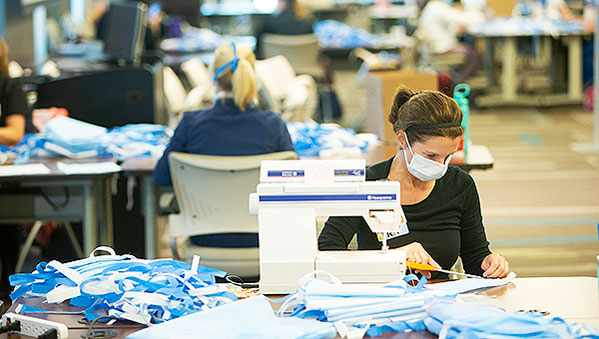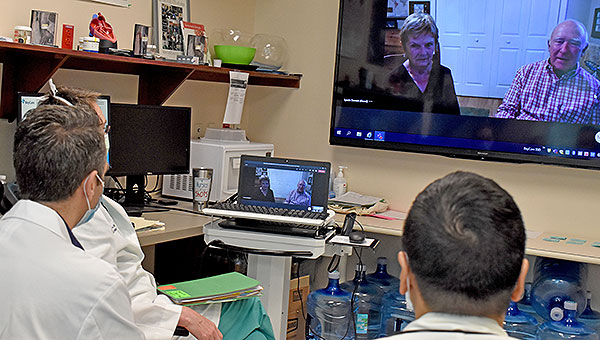The Pandemic’s Impact on the Health Care Industry
The U.S. health care industry had little warning that a new, highly infectious virus with deadly potential and no known treatments would arrive on its doorstep in early 2020.
“You tend to think we had several months to prepare for it. But it went from China to the U.S. in 30 days,” said Glenn Waters, executive vice president and chief operating officer of BayCare.
While U.S. hospitals usually have plans for dealing with mass casualties and natural disasters, few had contemplated, much less planned for, the arrival of a global pandemic that was the biggest threat to American lives since the 1918 Spanish flu. The disruptions to the health care industry were immediate and acute. One of the most immediate was the collapse of supply lines for personal protective equipment (PPE). To battle the highly contagious virus, health care workers needed to be protected from infection so they could care for sick patients. But the primary manufacturers of masks, face shields and gowns were in China, the country first hit by the novel coronavirus known as SARS-CoV-2. Supplies of PPE quickly dried up.
The industry learned that it had “too significant a reliance on a supply chain based in just one part of the world,” Waters said. While U.S. health care systems scrambled to find new suppliers, BayCare team members volunteered to make masks and face shields by hand in a large sewing room set up at system headquarters.
Another challenge was finding the space and beds to accommodate the influx of COVID-19 patients, but an even greater problem was staffing those beds. The industry has grappled with a serious shortage of nurses for several years. BayCare turned to computer modeling to try to predict COVID-19 surges so that plans could be made for beds and staffing.
“We had to do modeling to understand what our capacity was, what we expected the demand to be, and were we able to meet that demand,” said Ed Rafalski, senior vice president and chief strategy and marketing officer for BayCare. “The modeling was key in our preparation.”
Early in the pandemic, government mandates interrupted nonurgent surgeries in Florida. But what was unexpected was a longer lasting disruption to the industry that continued after the mandates ended: fear. Patients afraid of catching the virus canceled medical appointments and elective procedures and avoided emergency rooms. Hit by the double whammy of the virus and a reduction in people seeking routine care, some hospital systems were forced to lay off staff or eliminate services because of deteriorating bottom lines. BayCare, thanks to continued fiscal stewardship, was able to avoid layoffs.
Also unexpected was the amount of misinformation and conflicting messaging that was circulating in the United States, which left people unsure of how to protect themselves from the virus, said Nishant Anand, MD, executive vice president and chief medical officer for BayCare. “People weren’t informed. They were confused by rumors about treatments that would supposedly cure COVID-19,” he said. Health care leaders had to work hard, he said, to position themselves as informed, trusted advisers so they could educate their communities and correct inaccurate information.
Disruption as a Path to Innovation
Disruption to an industry can have positives too, and so it was with health care in 2020. “The pandemic led to innovations in health care. It allowed us to think about how we deliver services,” Anand said.
The most lasting of the innovations promoted by the pandemic is likely to be telemedicine. Before the coronavirus, the public’s response to the idea of visiting a doctor via computer or cell phone was lukewarm at best, and neither Medicare nor private health insurance companies were interested in covering such visits. “But when the pandemic hit, people very quickly responded,” Waters said. “They adopted telehealth out of necessity. Same thing for providers. They needed to see their patients and this was the most efficient way to do it.” The pandemic led the way for government and insurance companies to recognize and pay for telehealth for patients.
Also advanced by the pandemic was collaboration among hospital systems to balance patient loads. “We learned how interdependent we are,” Anand said. “None of us could do this alone. Together, we could.”
Looking Ahead
The pandemic pushed health care systems into an arena previously occupied primarily by government and local health departments: public health. When systems like BayCare stood up drive-through testing facilities, created web-based symptom checkers or call centers so people could ask questions about the virus, launched vaccine clinics, or advised schools and businesses about how to safely reopen, they were providing public health services.
Some of those experiences may accelerate a movement toward “population health” that was underway in the industry before the pandemic. Population health encourages providers to analyze and address the social determinants of health of different populations they serve, with the goal of keeping everyone healthier.
Finally, the pandemic has had a profound impact on America’s health care workers. Health care leaders who were already worried about the nursing shortage are waiting now to see whether nurses will leave their careers because of their pandemic experiences or whether even more students will enter nursing because they recognize, as never before, the complexity and importance of the work.
“Through all the uncertainty and upheaval in 2020, BayCare nurses remained strong in their commitment to the well-being of their patients, communities and each other,” said Lisa Johnson, senior vice president and chief nursing officer for BayCare.
However, taking care of severely ill patients while experiencing a much higher number of deaths takes a toll. Fear of contracting the virus or giving it to loved ones takes a toll. Getting in and out of protective equipment, including a tight-fitting mask and face shield, takes a toll.
“While nurses are very resilient and their unwavering commitment to their patients remains, we know the challenges our nurses have faced will leave a mark,” Johnson said. “We’re here to do whatever it takes to provide the care our front-line clinicians need for all the care and compassion they continue to deliver to our patients amidst many challenges.”



